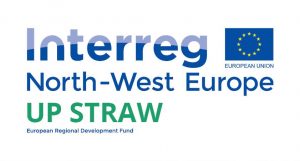We can ‘read’ and interpret strawbale public buildings in ways that will help to meet the objectives of the UP STRAW project, by applying critical  theory. Such readings reveal new ways of thinking about how to develop and increase the uses of straw in urban and public realms. In this piece, I’ve applied the ideas of two architects and used these ideas to ask a series of questions about straw and public buildings.
theory. Such readings reveal new ways of thinking about how to develop and increase the uses of straw in urban and public realms. In this piece, I’ve applied the ideas of two architects and used these ideas to ask a series of questions about straw and public buildings.
Robert Venturi from ‘Main Street is almost all right’
Robert Venturi takes a political view and provides important insights into the ways in which public buildings are valued. This seems particularly relevant in the UK which has been on the receiving end of the so-called austerity project, which has decimated public finances, building and confidence.
 ‘Architecture obviously reflects what a society holds important, what it values both spiritually and in terms of cash. In the pre-industrial past the major areas for expression were the temple, the church, the palace, agora, meeting house, country house and city hall; while in the present, extra money is spent on hotels, restaurants and all those commercial building types I have mentioned. Public housing and buildings expressing the local community or the public realm receive the cutbacks. Buildings representing consumer values generate the investment.’
‘Architecture obviously reflects what a society holds important, what it values both spiritually and in terms of cash. In the pre-industrial past the major areas for expression were the temple, the church, the palace, agora, meeting house, country house and city hall; while in the present, extra money is spent on hotels, restaurants and all those commercial building types I have mentioned. Public housing and buildings expressing the local community or the public realm receive the cutbacks. Buildings representing consumer values generate the investment.’
Charles Jencks from ‘Architecture 2000’
Charles Jencks argues that a revolution is needed to restore the integrity of public spaces. ‘If we are to have a credible architecture, it must be supported by a popular revolution that ends in a credible public realm.’
Can building with straw help to ameliorate the impact of cutbacks? Glynis Kirkwood (Lordship Hub Manager): “There is something special and unique about this building for a disadvantaged community. Because the building is special the community feels a bit more special and invested in. Visitors from more affluent areas have been surprised by the quality of the building and envious. They think a building like this should have been made for them.”
Can natural materials express values beyond those of commerce and profit? Glynis says that strawbale walls are easy to self-repair. She and her team go round with a bit of clay and simply do it themselves. This is both pleasurable and cost effective.
Can volunteering help local communities express and engage themselves in new and vibrant ways? Glynis: “The fact that many local people were actively involved in building the Hub has meant that they have an emotional and practical investment in it. There is a deep emotional investment in the building. People come in and help to repair things and keep the spaces clean and tidy. It feels like their home and they have no hesitation in sweeping up. So much so, I’ve made a dustpan and brush available so people can do that.”
How can natural building be in the vanguard of a ‘popular revolution’? In her Architects’ Journal article about the construction of Lordship Hub, Hattie Hartman describes the site as: ‘like no other construction site I had ever been on. For a start, it was predominantly female, with the all-female Anne Thorne Architects and the support of straw bale construction specialists Straw Works, run by the very knowledgeable Barbara Jones. The site was calm, efficient and doubled up as a place of learning. Members of the community are working with Straw Works to learn the straw bale construction technique.’ (https://schoolofnaturalbuilding.co.uk/public-straw-bale-building-in-london/)
Jencks uses theories of linguistics, anthropology and semiotics in order to see buildings and architecture in new ways. How do these theories help us to communicate UP STRAW?
He uses linguistics to explore the metaphorical impact of buildings. What are appropriate metaphors for straw public buildings? For example, Glynis references home in her phrase ‘homely vibe…”it feels like their homes.” She also refers to water when she says that “the organic shapes and textures of the walls encourage a free flow around and through the building.” When considering the Hub’s exterior, she says “it sits beautifully in the landscape.” Hattie Hartman describes the Hub as having ‘the potential to become a ‘green’ heart for Haringey.’
Jencks also uses anthropological classifications to interpret contemporary trends in architecture: he defined six major traditions that frame the development of architecture from the ‘logical’ to the ‘idealist’, the ‘self-conscious’, the ‘intuitive’, the ‘activist’ and the ‘unself-conscious’. How are these classifications relevant to UP STRAW?
Jencks applies semiotics to argue that the ‘architectural sign’ can be analysed into two parts, the signifier, which he called the ‘expression plane’, and the signified, or ‘content plane’. Signifiers give architecture its expression, according to Jencks, ie, form, space, surface, colour and texture; while signifieds constitute the ideas to which these signifiers refer. From this he detected the ‘fluidity’ of meaning in architecture. He uses semiotics to argue for a multiplicity of meanings in architecture and buildings.
What might straw public buildings truly mean? It’s evident that one of the important things a straw public building signifies is that people feel ‘invested in.’ A community feels special because of their involvement in the design and building of the space which, in turn, provides confidence, cohesion and connection with the building itself and within the community.
Jencks also refers to ‘a new shared language of expression’ by which he means ‘an aesthetic of undulating movement, fractured planes and spiralling growth, of wave-forms, twists and folds – a language more in tune with an unfolding, jumping cosmos than the rigid architectures of the past.’
It has often been observed that people will literally embrace the tactile qualities of strawbale buildings. Rae Parkinson of SNaB made specific reference to this phenomenon in relation to the rounded corners of windows and doorways during her clay plastering workshop at the Big Straw Bale Gathering. She suggested that although it’s perfectly possible to create straight lines in clay plastering, clients often prefer the undulations and rounded edges easily achieved through the use of natural materials but impossible with rigid plasterboard. Glynis also mentioned this: ‘people come in and stroke the walls.’
Finally, Jencks explores ways in which architecture can overcome ‘the historical dichotomies of body/mind and matter/spirit…that brings together these opposites into a comprehensive unity.’ Glynis: “It’s a very popular space for Yoga and Pilates. Teachers and participants comment positively on the ‘spiritual feel’ of the place.”
Perhaps, through the achievements of UP STRAW, we can help to overcome the differences between public/private?
A rainy August morning at the Hub:
